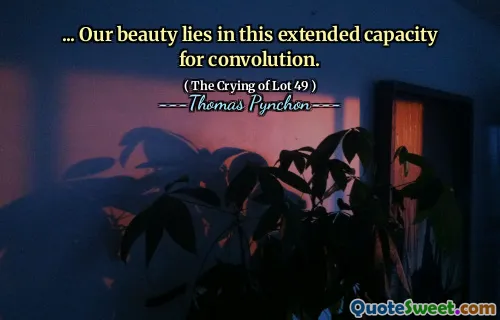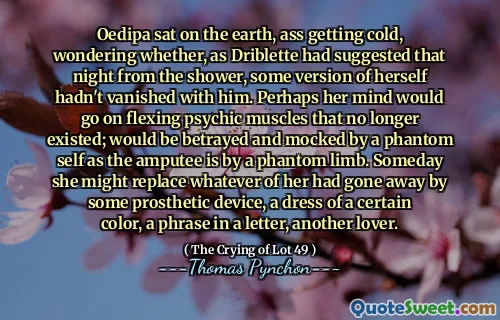"The Crying of Lot 49" is a novel by Thomas Pynchon that follows Oedipa Maas, a young woman who discovers a potential underground postal system called the Tristero. As Oedipa navigates her exploration of this secret network, she grapples with feelings of confusion and paranoia that arise as she uncovers layers of conspiracy intertwined with her life. The narrative is rich with symbolism and explores themes of communication, meaning, and disconnection in a modern society overwhelmed by information.
The novel takes on a surreal tone as Oedipa meets various eccentric characters, including a former lover and a cryptic lawyer, each adding to her sense of mystery and intrigue. As she delves deeper into the Tristero's significance, the lines between reality and illusion blur, leaving her—and the reader—questioning the truth of her findings. The intricacies of the plot and Pynchon's complex writing style contribute to the book's reputation as a postmodern classic.
Ultimately, "The Crying of Lot 49" challenges readers to reflect on the nature of communication and the chaotic interplay between acknowledgment and misunderstanding. The unresolved questions and the ambiguous ending serve as a metaphor for modern existential dilemmas, emphasizing the struggle to find meaning in a fragmented world. Pynchon's work remains relevant as it captures the complexities of human experience and the quest for connection amidst chaos.
Loading...
More »
Today Birthdays
1969 -
Sarah Vowell
1966 -
Chris Abani
1988 -
Hayley Williams
1906 -
Oscar Levant
1901 -
Marlene Dietrich
1571 -
Johannes Kepler
1555 -
Johann Arndt
1965 -
Salman Khan
1822 -
Louis Pasteur
1930 -
Meg Greenfield
1966 -
Bill Goldberg
1942 -
Thomas Menino
1986 -
Shelly-Ann Fraser-Pryce
1956 -
Karen Hughes
1960 -
Jeff Fortenberry
1974 -
Masi Oka
1952 -
David Knopfler
1948 -
Gerard Depardieu
1955 -
Barbara Olson
1727 -
Arthur Murphy

